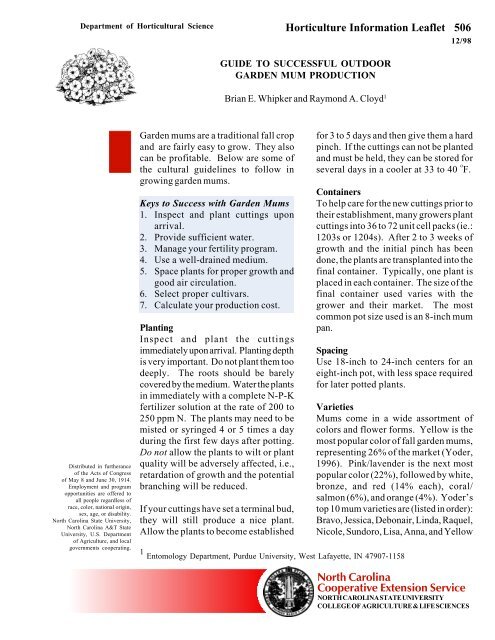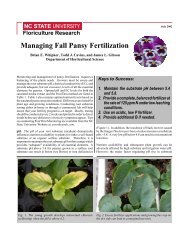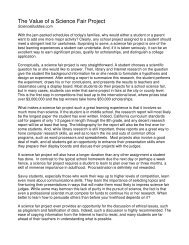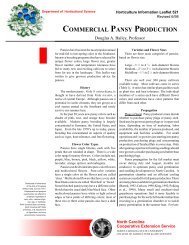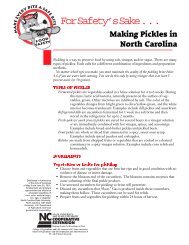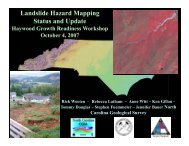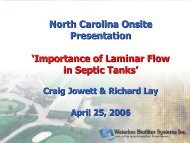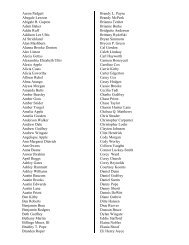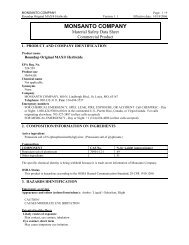Guide to Successful Garden Mum Production - North Carolina ...
Guide to Successful Garden Mum Production - North Carolina ...
Guide to Successful Garden Mum Production - North Carolina ...
You also want an ePaper? Increase the reach of your titles
YUMPU automatically turns print PDFs into web optimized ePapers that Google loves.
Department of Horticultural Science<br />
Distributed in furtherance<br />
of the Acts of Congress<br />
of May 8 and June 30, 1914.<br />
Employment and program<br />
opportunities are offered <strong>to</strong><br />
all people regardless of<br />
race, color, national origin,<br />
sex, age, or disability.<br />
<strong>North</strong> <strong>Carolina</strong> State University,<br />
<strong>North</strong> <strong>Carolina</strong> A&T State<br />
University, U.S. Department<br />
of Agriculture, and local<br />
governments cooperating.<br />
<strong>Garden</strong> mums are a traditional fall crop<br />
and are fairly easy <strong>to</strong> grow. They also<br />
can be profitable. Below are some of<br />
the cultural guidelines <strong>to</strong> follow in<br />
growing garden mums.<br />
Keys <strong>to</strong> Success with <strong>Garden</strong> <strong>Mum</strong>s<br />
1. Inspect and plant cuttings upon<br />
arrival.<br />
2. Provide sufficient water.<br />
3. Manage your fertility program.<br />
4. Use a well-drained medium.<br />
5. Space plants for proper growth and<br />
good air circulation.<br />
6. Select proper cultivars.<br />
7. Calculate your production cost.<br />
Planting<br />
Inspect and plant the cuttings<br />
immediately upon arrival. Planting depth<br />
is very important. Do not plant them <strong>to</strong>o<br />
deeply. The roots should be barely<br />
covered by the medium. Water the plants<br />
in immediately with a complete N-P-K<br />
fertilizer solution at the rate of 200 <strong>to</strong><br />
250 ppm N. The plants may need <strong>to</strong> be<br />
misted or syringed 4 or 5 times a day<br />
during the first few days after potting.<br />
Do not allow the plants <strong>to</strong> wilt or plant<br />
quality will be adversely affected, i.e.,<br />
retardation of growth and the potential<br />
branching will be reduced.<br />
If your cuttings have set a terminal bud,<br />
they will still produce a nice plant.<br />
Allow the plants <strong>to</strong> become established<br />
Horticulture Information Leaflet 506<br />
12/98<br />
GUIDE TO SUCCESSFUL OUTDOOR<br />
GARDEN MUM PRODUCTION<br />
Brian E. Whipker and Raymond A. Cloyd 1<br />
for 3 <strong>to</strong> 5 days and then give them a hard<br />
pinch. If the cuttings can not be planted<br />
and must be held, they can be s<strong>to</strong>red for<br />
several days in a cooler at 33 <strong>to</strong> 40 o F.<br />
Containers<br />
To help care for the new cuttings prior <strong>to</strong><br />
their establishment, many growers plant<br />
cuttings in<strong>to</strong> 36 <strong>to</strong> 72 unit cell packs (ie.:<br />
1203s or 1204s). After 2 <strong>to</strong> 3 weeks of<br />
growth and the initial pinch has been<br />
done, the plants are transplanted in<strong>to</strong> the<br />
final container. Typically, one plant is<br />
placed in each container. The size of the<br />
final container used varies with the<br />
grower and their market. The most<br />
common pot size used is an 8-inch mum<br />
pan.<br />
Spacing<br />
Use 18-inch <strong>to</strong> 24-inch centers for an<br />
eight-inch pot, with less space required<br />
for later potted plants.<br />
Varieties<br />
<strong>Mum</strong>s come in a wide assortment of<br />
colors and flower forms. Yellow is the<br />
most popular color of fall garden mums,<br />
representing 26% of the market (Yoder,<br />
1996). Pink/lavender is the next most<br />
popular color (22%), followed by white,<br />
bronze, and red (14% each), coral/<br />
salmon (6%), and orange (4%). Yoder’s<br />
<strong>to</strong>p 10 mum varieties are (listed in order):<br />
Bravo, Jessica, Debonair, Linda, Raquel,<br />
Nicole, Sundoro, Lisa, Anna, and Yellow<br />
1 En<strong>to</strong>mology Department, Purdue University, West Lafayette, IN 47907-1158<br />
<strong>North</strong> <strong>Carolina</strong><br />
Cooperative Extension Service<br />
NORTH CAROLINA STATE UNIVERSITY<br />
COLLEGE OF AGRICULTURE & LIFE SCIENCES
Triumph. Match your cultivars with the colors<br />
popular in your market and the length of your marketing<br />
season.<br />
Pinching<br />
Rooted cuttings are pinched 7 <strong>to</strong> 14 days after<br />
potting. Timing of the pinch varies with plant<br />
growth. Pinching should occur after the plants have<br />
become established and actively growing (ie.: 1 <strong>to</strong><br />
1 1 /2 inches of new <strong>to</strong>p growth has developed and the<br />
roots are visible at the side of the tray pack). Remove<br />
around 1 /2 inch of growth. A second and third pinch<br />
may be required on the plants. Second and third<br />
pinches should be done after 3 <strong>to</strong> 4 inches of new<br />
growth has developed on the breaks, removing around<br />
1/2 inch of growth. Generally in the Southeast, the last<br />
pinch date should be between July 10 and July 25 and<br />
up <strong>to</strong> a week earlier in the northern US. Pinching <strong>to</strong>o<br />
late will delay flowering. An alternative <strong>to</strong> the<br />
second and third pinches is covered below under<br />
Florel.<br />
Florel as a Pinching Agent<br />
The requirement of pinching garden mums for the<br />
second and third times is very labor intensive and<br />
2<br />
costly. A relatively new production practice adopted<br />
by a number of growers is <strong>to</strong> replace these subsequent<br />
pinches with an application of Florel. Research by<br />
Whipker (1996) compared the economics of Florel<br />
and a second pinch (Table 1). The use of Florel<br />
resulted in labor savings of almost 3¢ per plant, or<br />
a $294 savings per 10,000 mums.<br />
Florel is a liquid formulation of ethephon (an ethylene<br />
producer) and acts as a plant growth regula<strong>to</strong>r by:<br />
• Stimulating lateral branching<br />
• Controlling stem elongation<br />
• Encouraging vegetative growth while controlling<br />
flowering.<br />
A rate of 500 ppm is commonly used as a substitute<br />
for the second pinch, which occurs roughly 30 <strong>to</strong> 40<br />
days after potting. Research at <strong>North</strong> <strong>Carolina</strong> State<br />
University by Larson and McCall (1995) found that<br />
a single application of Florel at 500 ppm produced<br />
good quality plants that were comparable <strong>to</strong> plants<br />
manually pinched a second time. Florel treated<br />
plants had a slight delay in the appearance of buds<br />
compared <strong>to</strong> the manually pinched plants, but the<br />
difference was not noticeable at the conclusion of the<br />
Table 1. Comparing the production cost of replacing the second pinch of garden mums with an<br />
application of Florel.<br />
. . Florel . 2 nd Pinch<br />
.. . . Cost Per Pot.<br />
Labor and Chemicals . .<br />
Pinch #1 . .$0.0028 . .$0.0028<br />
Pinching Option . . . .<br />
Pinch #2 . . . $0.0306<br />
B-Nine . $0.0070 . $0.0120<br />
B-Nine Application Labor . $0.0040 . $0.0040<br />
Florel Option . . . .<br />
Florel . $0.0022 . .<br />
Florel Application Labor . $0.0040 . .<br />
. TOTAL $0.0200 . $0.0494<br />
Difference . $0.0294 .<br />
Total Savings with Large Number 30,000 <strong>Mum</strong>s $882<br />
of Pots Produced 50,000 <strong>Mum</strong>s $1,470<br />
70,000 <strong>Mum</strong>s . $2,058<br />
.
experiment. Florel causes flower bud abortion,<br />
and the final application should be at least 6 <strong>to</strong> 7<br />
weeks prior <strong>to</strong> the scheduled flowering date <strong>to</strong><br />
avoid delay of flowering. Florel also works as a<br />
plant growth regula<strong>to</strong>r by controlling plant height.<br />
Adjust your use of plant growth regula<strong>to</strong>rs like B-<br />
Nine as needed.<br />
Some growers apply multiple applications of Florel<br />
<strong>to</strong> delay flowering and produce a larger plant, hence<br />
spreading out their marketing season for garden<br />
mums. Discuss this option with your plant broker <strong>to</strong><br />
determine a production schedule that is suitable for<br />
your operation.<br />
Plant Growth Regula<strong>to</strong>rs<br />
Plant growth varies with the cultivars and some can<br />
get <strong>to</strong>o tall and require the application of a plant<br />
growth regula<strong>to</strong>r. Growers will require at least a<br />
minimal amount of growth regula<strong>to</strong>r. A plant growth<br />
regula<strong>to</strong>r should be applied after the final pinch,<br />
when 1 1/2 inches <strong>to</strong> 2 1/2 inches of new growth has<br />
occurred. This will reduce plant height, intensify the<br />
dark green color of the foliage, and most importantly<br />
create rounder, more uniform plants. Yoder<br />
recommends foliar sprays of B-Nine at 2500 ppm,<br />
starting around 2 weeks after the last pinch.<br />
Additional applications at the same rate can be used<br />
if the plants begin <strong>to</strong> stretch. Do Not apply after buds<br />
are visible or a reduction in flower diameter is<br />
possible.<br />
Sumagic is a very active chemical. Growers need <strong>to</strong><br />
experiment with a small amount of their crop <strong>to</strong> test<br />
the effectiveness and determine optimal rates.<br />
Cultivar response will vary. The label rate for<br />
Sumagic is 2.5 <strong>to</strong> 10 ppm, with lower rates suggested<br />
for cool growing climates. Start with the lower<br />
range of suggested rates.<br />
Whether using B-Nine or Sumagic, remember <strong>to</strong><br />
reduce the plant growth regula<strong>to</strong>r rate if you are<br />
applying Florel.<br />
Fertilization and Irrigation<br />
Maintain root medium pH between 5.8 <strong>to</strong> 6.2 for<br />
soilless media and 6.0 <strong>to</strong> 6.5 for soil based media.<br />
Use a complete N-P-K fertilizer such as Excel ® 15-<br />
5-15 Cal-Mag or 20-10-20 (with supplemental<br />
3<br />
calcium, magnesium, and mirconutrients being<br />
applied) at the rate of 200 <strong>to</strong> 250 ppm N and K<br />
applied in the irrigation water. Use a fertilizer that<br />
provides 60 <strong>to</strong> 75% of the nitrogen in the nitrate<br />
(NO 3 -N) form. Slightly lower fertilization rates may<br />
be sufficient for a soil-based medium, while slightly<br />
higher rates are suggested for a bark-based mix.<br />
Growers need <strong>to</strong> manage their fertility program <strong>to</strong><br />
avoid excessive electrical conductivity (EC) buildup<br />
or leach salts every month. Research by Larson and<br />
McCall (1995) at <strong>North</strong> <strong>Carolina</strong> State University<br />
found that higher fertilization rates of 500 ppm N did<br />
not provide any additional benefit when compared <strong>to</strong><br />
300 ppm N.<br />
Table 2. <strong>Guide</strong>lines for foliar analysis values<br />
(based on dry weights) for mums.<br />
Nutrient<br />
Recommended<br />
Concentration<br />
N (%) 4.00 <strong>to</strong> 6.50<br />
P (%) 0.25 <strong>to</strong> 1.00<br />
K (%) 3.50 <strong>to</strong> 6.50<br />
Ca (%) 0.50 <strong>to</strong> 2.00<br />
Mg (%) 0.30 <strong>to</strong> 0.60<br />
B (ppm) 25 <strong>to</strong> 100<br />
Cu (ppm) 5 <strong>to</strong> 50<br />
Fe (ppm) 50 <strong>to</strong> 300<br />
Mn (ppm) 30 <strong>to</strong> 350<br />
Zn (ppm) 15 <strong>to</strong> 50<br />
Foliage of plants was sampled prior <strong>to</strong> or at flowering.<br />
Samples taken from the <strong>to</strong>p-most, fully expandedleaves<br />
and are only guidelines.<br />
Source: Plant Analysis Handbook for Georgia, 1988.<br />
Table 3. Element deficiency symp<strong>to</strong>ms.<br />
Nitrogen Reduction in plant vigor and small, light<br />
(N) green <strong>to</strong> yellowish foliage. In severe<br />
cases, lower leaves are chlorotic and<br />
have reddish veins and margins.<br />
Growth and flower size are reduced<br />
and flowering date is delayed.<br />
Phosphorus Lower leaves turn reddish <strong>to</strong> yellow <strong>to</strong><br />
(P) brown beginning at the leaf apex. Leaf<br />
size of newly developed leaves is<br />
reduced and lower stem portions may<br />
develop a deep purple color.<br />
Potassium Lack of plant vigor, small leaves and<br />
(K) weak stems with first appearance on<br />
lower leaves.<br />
(continued on the next page)
Table 3. Element deficiency symp<strong>to</strong>ms.<br />
(continued)<br />
Potassium In severe cases, leaves develop<br />
(K) interveinal and marginal chlorosis<br />
continued followed by necrosis.<br />
Calcium Small, curled, thickened leaves around<br />
(Ca) growing point. In severe cases, death<br />
of growing point and rosetting of<br />
leaves. Peduncles break over about<br />
time flower color shows and flowers<br />
have poor keeping quality. Stubby and<br />
brown roots.<br />
Magnesium Appears first as interveinal chlorosis<br />
(Mg) and curling under of older leaves.<br />
Veins remain green. Severe cases<br />
have reddish colored spots<br />
interveinally and along leaf margins,<br />
gradually moving <strong>to</strong> upper leaves.<br />
Boron Red pigment in veins with interveinal<br />
(B) chlorosis. Corky veins and sides of<br />
petioles with brittle, downward-cupped<br />
leaves. Terminal bud may die or<br />
secondary flower buds fail <strong>to</strong> develop<br />
normally. Larger flowers do not open<br />
fully and are more incurved than<br />
normal. Roots brown and stubby.<br />
Copper Dull green leaves, chlorotic veins.<br />
(Cu) Veinal chlorosis produces inverse<br />
“netting.” Margins remain green.<br />
Affected leaves wilt during day, outer<br />
margins turning upward. Flowers are<br />
small, reflex, and soft.<br />
Iron Interveinal chlorosis of young leaves<br />
(Fe) becoming a general chlorosis in leaves<br />
severely affected. A common<br />
deficiency at high root medium pHs.<br />
Manganese Generally pale green plants with mild<br />
(Mn) interveinal chlorosis of young leaves<br />
not as distinctly outlined as in iron<br />
deficiency. Severe cases with small<br />
necrotic spots in middle leaves,<br />
affecting up <strong>to</strong> 1/4 of the surface.<br />
Interveinal, first white or gray, then<br />
tan.<br />
Zinc (Z) A rarely seen deficiency. Appears as<br />
plant approaches blooming stage.<br />
Small chloritic spots at any position on<br />
middle or upper leaves. Chlorotic spots<br />
gradually develop necrotic spots in the<br />
center.<br />
Source: Rauls<strong>to</strong>n, J.C., W.E. Waters, S.S. Woltz, and C.M. Geraldson. 1972.<br />
Summary of chrysanthemum fertilization programs for field production in<br />
Florida. Florida Flower Grower 9 (10), p. 9.<br />
4<br />
Inducing Flowers<br />
<strong>Garden</strong> mums are pho<strong>to</strong>periodic plants. Which means<br />
the length of day (or more correctly, length of darkness)<br />
influences the flowering pattern of the plant. The<br />
critical night length <strong>to</strong> cause garden mums <strong>to</strong> initiate<br />
flowers is between 9.5 <strong>to</strong> 10 .5 hours (Pertuit, 1996).<br />
Most cultivars on the market will naturally flower<br />
during September 10 <strong>to</strong> Oc<strong>to</strong>ber 10. Consult your<br />
cutting supplier for establishing a schedule that meets<br />
your market demands.<br />
Growers can also extend their marketing season by<br />
shading plants <strong>to</strong> induce earlier flowering. A shading<br />
system utilizing black cloth or black plastic is used<br />
during the approximately seven weeks required <strong>to</strong><br />
induce flowering. The shading system is pulled over<br />
the plants at dusk <strong>to</strong> limit heat buildup under the cloth<br />
and removed early in the morning. This provides at<br />
least 11 <strong>to</strong> 12 hours of darkness. High average<br />
temperatures can cause heat delay, with flowering<br />
potentially being delayed 1 <strong>to</strong> 3 weeks. The shade cloth<br />
is not used on evenings when heavy rainfall is expected<br />
due <strong>to</strong> water pooling on the cloth. A sample schedule<br />
for shading plants is given in Table 4.<br />
Scheduling/Timing<br />
An example schedule is given for producing a natural<br />
season garden mum, Table 5. This is a basis for<br />
planning your schedule, but variations will occur due<br />
<strong>to</strong> variety selection, environmental conditions, and<br />
fertility programs. Consult your cutting supplier for<br />
setting up a cus<strong>to</strong>mized schedule for your operation.<br />
Cost of <strong>Production</strong><br />
Profitable production of garden mums is dependent<br />
upon the knowledge and control of production costs. A<br />
grower who understands production costs will be<br />
better prepared <strong>to</strong> make decisions on the optimal<br />
number of plants <strong>to</strong> produce and <strong>to</strong> help establish<br />
prices. The costs presented here should be useful <strong>to</strong><br />
current growers who wish <strong>to</strong> compare their own<br />
production expenses and for potential growers in<br />
determining whether <strong>to</strong> begin growing garden mums.<br />
The data was collected from a Midwestern grower who<br />
produced 70,000 garden mums. Costs are calculated<br />
for the 1996 growing year, Table 6.<br />
Costs: variable versus fixed. Costs can be categorized<br />
as either variable or fixed. Variable costs, also called
Table 4. Early shaded garden mum timetable - 1997 (6" or 6-½” pots - one cutting per pot).<br />
Plant Approximate Approximate Flower<br />
First Pinch Second Pinch Shade 7 Weeks<br />
Apr. 28 May 12 June 02 June 02 July 21<br />
May 05 May 9 June 09 June 09 July 28<br />
May 12 May 26 June 16 June 16 Aug. 04<br />
May 19 June 02 June 23 June 23 Aug. 11<br />
May 26 June 09 June 30 June 30 Aug. 18<br />
June 02 June 16 July 07 July 07 Aug. 25<br />
June 09 June 23 July 14 July 14 Sep. 01<br />
Based on starting with a rooted cutting. Long days provided until the shade date. Source: Yoder’s 1996-1997 <strong>Garden</strong> <strong>Mum</strong>s <strong>Guide</strong>.<br />
Table 5. Example production schedule for natural season garden mums.<br />
Date Second Pinch Schedule Florel Schedule<br />
May 20 Pot Pot<br />
June 3 Pinch 1 Pinch 1<br />
June 17 Pinch 2 Florel Application 2<br />
July 1 B-Nine Application 1 .<br />
July 15 B-Nine Application 3 B-Nine Application<br />
July 29 B-Nine Application 3 .<br />
Mid-September <strong>to</strong> mid-Oc<strong>to</strong>ber Flowering 4 Flowering 4<br />
1 B-Nine applied after the last pinch when 1½ <strong>to</strong> 2½ inches of the growth has occurred.Additiona application used only if<br />
needed.<br />
2 Florel applied as a substitute for a second pinch at 500 ppm.<br />
3 B-Nine application only required if excessive growth has occurred.<br />
4 Cultivar dependent.<br />
direct costs, are costs that are incurred directly by<br />
growing the crop. Variable costs items are the basic<br />
inputs required <strong>to</strong> grow a crop, such as pots, plants,<br />
media, or chemicals. These items’ costs are fairly<br />
easy <strong>to</strong> allocate <strong>to</strong> a specific crop because you know<br />
the materials used <strong>to</strong> produce the crop and production<br />
practices you followed. The direct costs are $0.98<br />
per pot.<br />
Fixed costs, also called overhead or indirect costs,<br />
are incurred whether or not a crop is produced. They<br />
include items like management salaries, depreciation,<br />
insurance, interest, repairs, and taxes. Fixed costs<br />
5<br />
represent general operation expenses present in every<br />
greenhouse facility. To get a good measure of<br />
profitability, these costs need <strong>to</strong> be allocated <strong>to</strong> each<br />
crop grown. In general, for greenhouse operations,<br />
fixed costs are allocated <strong>to</strong> a crop on a cost-per-ft2<br />
-per-week basis. Because garden mums are grown<br />
outdoors, fixed costs were allocated <strong>to</strong> the mum crop<br />
on a percentage basis, based on: the actual use of a<br />
piece of equipment or as a percentage of sales. The<br />
remaining percentage not allocated <strong>to</strong> the mum crop<br />
would then be allocated <strong>to</strong> the other crops produced<br />
like bedding plants or poinsettias.
Fixed costs are only $0.05 per pot.The fairly low<br />
depreciation expense can be attributed <strong>to</strong> this firm’s<br />
reliance on used equipment. Firms which purchase<br />
new machinery and equipment will have a higher<br />
depreciation expense.<br />
Shrink. Even under the best production practices, a<br />
certain percentage of the crop will not be marketable<br />
due <strong>to</strong> poor growth, insects, disease, or damage. The<br />
cost of inputs for these non-marketable plants have<br />
<strong>to</strong> be accounted for by the operation. This is done by<br />
adjusting the production cost by a shrink fac<strong>to</strong>r. In<br />
this case, a 3% shrink was calculated which involved<br />
Table 6. Example production costs for natural<br />
season garden mums.<br />
Cost per<br />
Item Pot<br />
Direct Items<br />
Cutting $0.2000<br />
Pot/Soil $0.2410<br />
Fertilizer $0.0200<br />
Chemicals $0.1746<br />
Sub-Total $0.635<br />
Labor $0.3007<br />
Sub-Total Indirect Costs $0.936<br />
Interest on Direct Expenses $0.0421<br />
(Direct expenses * 9% interest * 0.5 years)<br />
Total Direct Costs $0.936<br />
Indirect Costs<br />
Equipment/Interest/Repairs $0.228<br />
Overhead Operation Costs $0.2263<br />
Full-time labor $0.2868<br />
Utilities/Taxes/Misc. Costs $0.513<br />
Sub-Total<br />
Total Indirect Costs $0.741<br />
Total <strong>Production</strong> Costs $1.720<br />
3% Loss (divide T.P.C. by 0.97) $0.0532<br />
Total Costs (including shrink) $1.773<br />
Delivery Cost (Labor and Expenses) $0.30<br />
Total Costs (Delivered) $2.073<br />
Revenue<br />
Wholesale Price: $2.70<br />
Non-delivered and Delivered<br />
Total Net Profit per Pot (Wholesale)<br />
Non-Delivered $0.927<br />
Delivered $0.627<br />
6<br />
dividing the <strong>to</strong>tal production costs by 0.97 <strong>to</strong> get the<br />
<strong>to</strong>tal production costs (including shrink). Total<br />
production costs will increase for growers who have<br />
a higher percent of shrink.<br />
Total production costs per pot , including a 3%<br />
shrink and costs for marketing the crop was $2.07.<br />
Profitability. By adding the <strong>to</strong>tal variable costs and<br />
<strong>to</strong>tal fixed costs <strong>to</strong>gether, this provides the <strong>to</strong>tal costs<br />
of producing a crop. The profitability of the crop is<br />
directly related <strong>to</strong> the price received. The profitability<br />
per pot of a delivered garden mum was $0.627 (a<br />
23% profit margin).<br />
Using the method outline in this handout will enable<br />
mum growers the ability <strong>to</strong> compare the profitability<br />
of their crops for their own operation. Of course<br />
costs will vary among greenhouses according <strong>to</strong><br />
their amount of capitalization in equipment and<br />
structures and their ability <strong>to</strong> purchase inputs at<br />
lower costs. Therefore, each operation will need <strong>to</strong><br />
calculate their specific production costs in order <strong>to</strong><br />
determine their own profitability.<br />
Diseases<br />
The primary diseases of garden mums are bacterial<br />
leaf spot, Sep<strong>to</strong>ria leaf spot, Pythium, and Botrytis.<br />
Bacterial leaf spot is caused by Pseudomonas<br />
cichorii which is often more prevalent following<br />
periods of heavy summer rains. Bacterial leaf spot<br />
development is favored by moisture, high humidity,<br />
high temperatures, and/or use of susceptible cultivars.<br />
Bacterial leaf spot symp<strong>to</strong>ms include dark-brown <strong>to</strong><br />
black spots that can cover half the leaf. These spots<br />
eventually expand <strong>to</strong> irregularly shaped lesions. The<br />
disease typically begins at the lower leaves and will<br />
spread upward, usually on one side of the plant.<br />
Rogue infected plants and apply Bordo-Mix 12.75WP<br />
or Kocide 101 77WP (copper hydroxide) <strong>to</strong><br />
susceptible cultivars.<br />
Sep<strong>to</strong>ria leaf spot is caused by Sep<strong>to</strong>ria<br />
chrysanthemella, and symp<strong>to</strong>ms include small<br />
yellow spots that later turn dark brown <strong>to</strong> black.<br />
Later, leaves may turn yellow and drop from the plant<br />
or may remain attached <strong>to</strong> the stems. The disease is<br />
spread by splashing water, so overhead watering<br />
should be avoided. Cleary’s 3336, Daconil 2787
75WP, Domain, Kocide 101 77WP, or Systec 1998<br />
4F are labeled for Sep<strong>to</strong>ria leaf spot.<br />
Pythium is usually present in most media. Growers<br />
should avoid growing conditions which stress the<br />
plant, such as continuously water-logged medium,<br />
high EC levels, cool medium temperatures, or cool<br />
air temperatures. If needed, monthly drenches of<br />
Aliette, Banrot, or Subdue Maxx can be applied.<br />
Figure 1. Common garden mum insect pests.<br />
Chrysanthemum aphid. A adult, B<br />
young nymph, C older nymph.<br />
Beet armyworm. A adult, B-C eggs,<br />
D egg mass, E-F larvae.<br />
Corn earworm. A-B adults, C eggs, D<br />
larva<br />
Green peach aphid. A winged adult, B<br />
wingless adult, C nymph with wing buds.<br />
Botrytis can also be a problem on leaves and flowers.<br />
Avoid overhead watering and space plants <strong>to</strong> allow<br />
for good air circulation. Fungicides registered for<br />
control of Botrytis on chrysanthemums are fludioxinil<br />
(Medallion), iprodione (Chipco 26019), mancozeb<br />
(Protect T/O), and vinclozolin (Ornalin).<br />
Melon aphid. A-B winged adults, C<br />
wingless adult, D-E nymphs.<br />
European corn borer. A adult, B eggs,<br />
C larva, D pupa.<br />
Source: J. R. Baker (ed.). 1994. Insect and related pests of flowers and foliage plants. N.C. Cooperative Extension Service Bulletin AG-136. 106 pp.<br />
Insects and Mites<br />
<strong>Garden</strong> mums are less susceptible <strong>to</strong> insect and mite<br />
pests compared <strong>to</strong> florist mums. However, garden<br />
mums can be attacked by a number of insect/mite<br />
pests such as aphids, caterpillars, leaf miners, spider<br />
mites, and thrips, Figure 1. Most pests can be managed<br />
with a proper scouting program. Early pest detection<br />
can lead <strong>to</strong> fewer problems, especially when pest<br />
7<br />
populations are low compared <strong>to</strong> controlling high<br />
pest populations or populations that are rapidly<br />
building up. In addition, early pest detection can<br />
maximize the effectiveness of foliar-applied and/or<br />
systemic pesticides.<br />
Aphids. Chrysanthemum aphid, green peach aphid,<br />
and melon aphid are the common species that feed on
garden mums. Aphids feed on terminal growth, flower<br />
buds prior <strong>to</strong> opening, and on leaves in the plant<br />
interior when plants are bushy. They feed on plant<br />
tissue with their piercing-sucking mouthparts causing<br />
plant stunting, wilting, leaf yellowing, and leaf<br />
curling. A by-product of their feeding is a clear,<br />
sticky honeydew substance that coats plant leaves.<br />
Honeydew serves as a medium for black sooty mold<br />
fungus. The presence of black sooty mold fungus and/<br />
or aphid cast-skins can reduce crop marketability.<br />
Aphids are soft-bodied insects that have tubes<br />
(cornicles) located on their abdomens. Females can<br />
give birth <strong>to</strong> 60 <strong>to</strong> 100 live young per day for a period<br />
of 20 <strong>to</strong> 30 days. This ability <strong>to</strong> reproduce quickly<br />
leads <strong>to</strong> tremendous numbers within a short period of<br />
time.<br />
Aphids feeding on exposed terminals or flower buds<br />
allow for better control with contact insecticides.<br />
However, aphids feeding within the plant canopy are<br />
harder <strong>to</strong> control with contact insecticides, because<br />
it is difficult <strong>to</strong> get thorough coverage. When garden<br />
mums are placed outside, aphids are exposed <strong>to</strong><br />
many natural enemies which may provide some<br />
control. For example, female parasitic wasps will<br />
lay eggs inside aphids and eventually turn aphids in<strong>to</strong><br />
gray-brown mummies.<br />
Chemicals used for aphid control include acephate<br />
(Orthene), azadirachtin (Azatin), bifenthrin (Talstar),<br />
chlorpyrifos (Duraguard), diazinon (Knox-Out),<br />
endosulfan (Thiodan), fenpropathrin (Tame),<br />
horticultural oil (Ultra-Fine Sun Spray),<br />
imidacloprid (Marathon), insecticidal soap (M-<br />
Pede), and methiocarb (Mesurol).<br />
Leaf Miners. Leaf miners can cause considerable<br />
damage <strong>to</strong> garden mums if not detected early.<br />
Chrysanthemum and serpentine leaf miners are the<br />
common species that infest garden mums. Adult<br />
females puncture the leaf surface and lay eggs inside<br />
the leaf with their oviposi<strong>to</strong>r. Eggs hatch in<strong>to</strong> larvae<br />
that tunnel between the upper and lower leaf surfaces<br />
creating white blotches and/or twisting mines. These<br />
mines can disfigure leaves and reduce crop<br />
marketability.<br />
Chemicals used for leaf miner larvae control are<br />
abamectin (Avid), acephate (Orthene), azadirachtin<br />
8<br />
(Azatin), and cyromazine (Citation). Chemicals used<br />
for adult control are chlorpyrifos (Duraguard) and<br />
permethrin (Astro).<br />
Spider mites. Two-spotted spider-mite is the<br />
common species that can infest garden mums. Spider<br />
mites feed primarily on leaf undersides removing<br />
plant sap (chlorophyll) with their stylet-like<br />
mouthparts. Their feeding causes leaves <strong>to</strong> have a<br />
“stippled” appearance which appears on the leaf<br />
upper side. Severe mite damage can cause leaf drop.<br />
Two-spotted spider mites are yellow-brown <strong>to</strong> dark<br />
green in color with two dark spots on both sides of<br />
the body. Mites are a problem under dry and warm<br />
(70 o F) weather conditions. Development from egg<br />
<strong>to</strong> adult can occur within 14 <strong>to</strong> 21 days depending on<br />
temperature. The higher the temperature the less time<br />
it takes <strong>to</strong> go from egg <strong>to</strong> adult.<br />
Chemicals used for control of spider mites are<br />
abamectin (Avid), bifenthrin (Talstar), dicofol<br />
(Kelthane), fenpropathrin (Tame), horticultural oil<br />
(Ultra-Fine Sun Spray), and pyridaben (Sanmite).<br />
Thrips. Western flower thrips and flower thrips are<br />
the two most common species that attack garden<br />
mums. Thrips feed on leaves and flowers with their<br />
rasping-piercing-sucking mouthparts. They cause<br />
leaves <strong>to</strong> have a silvery-appearance and they leave<br />
black fecal droppings. Thrips can also damage<br />
flowers by scarring the petals, deforming flower<br />
buds, and causing bud abortion.<br />
Thrips are generally a problem when the crop is in<br />
the greenhouse. Thrips are small insects<br />
approximately 1 <strong>to</strong> 2 mm (1/8 inch) long. Females lay<br />
eggs in<strong>to</strong> leaves or flower petals. When young emerge<br />
from eggs they feed on leaves and flower buds.<br />
Thrips pupate in soil, leaf litter, and even on plants.<br />
After pupation, they emerge as winged adults. Once<br />
thrips enter unopened flower buds they are extremely<br />
difficult <strong>to</strong> kill with contact insecticides.<br />
Chemicals used for thrips control include abamectin<br />
(Avid), acephate (Orthene), azadirachtin (Azatin),<br />
Beauveria bassiana (Naturalis-O/Botaniguard),<br />
chlorpyrifos (Duraguard), diazinon (Knox-Out), and<br />
fenpropathrin (Tame).
Caterpillars. Beet armyworm, cabbage looper, corn<br />
earworm, European corn borer, and fall armyworm<br />
can infest garden mums. Caterpillars can infest almost<br />
all aboveground portions of plants. They feed on<br />
leaves, stems, and flower/terminal buds. Adult<br />
females (moths) lay eggs on plant parts. Young<br />
larvae emerge from eggs and begin feeding.<br />
Caterpillars consume more as they mature until they<br />
reach the stage where they are ready <strong>to</strong> pupate and<br />
then turn in<strong>to</strong> adults. Adults generally migrate on<strong>to</strong><br />
garden mums when the plants are placed outside.<br />
Chemicals used for caterpillar control include<br />
acephate (Orthene), Bacillus thuringiensis (Dipel),<br />
bifenthrin (Talstar), cyfluthrin (Decathlon),<br />
fluvalinate (Mavrik), and permethrin (Astro).<br />
When using chemicals be sure <strong>to</strong> read the label and<br />
wear appropriate protective clothing. Also, apply<br />
chemicals when the environmental conditions are<br />
favorable <strong>to</strong> avoid phy<strong>to</strong><strong>to</strong>xicity.<br />
For Further Reading:<br />
• Larson, R.A. and I.F. McCall. 1995.<br />
<strong>Garden</strong> chrysanthemum culture the easy<br />
way. <strong>North</strong> <strong>Carolina</strong> Flower Growers’<br />
Bull. 40(6):1-3.<br />
• Pertuit, A.J. Jr. 1996. <strong>Garden</strong> mums.<br />
Georgia Floriculture 6(4):14-18.<br />
• Pundt, L. 1995. Watch for these pests of<br />
garden mums. Connecticut Greenhouse<br />
Newsletter, No. 185, Apr./May 1995.<br />
• Whipker, B.E. 1996. Cost of producing<br />
containerized garden mums: 1996. <strong>North</strong><br />
<strong>Carolina</strong> Flower Growers’ Bull. 41(4):1-<br />
6.<br />
• Yoder <strong>Garden</strong> <strong>Mum</strong> Cultural Manual,<br />
1996-1997.


